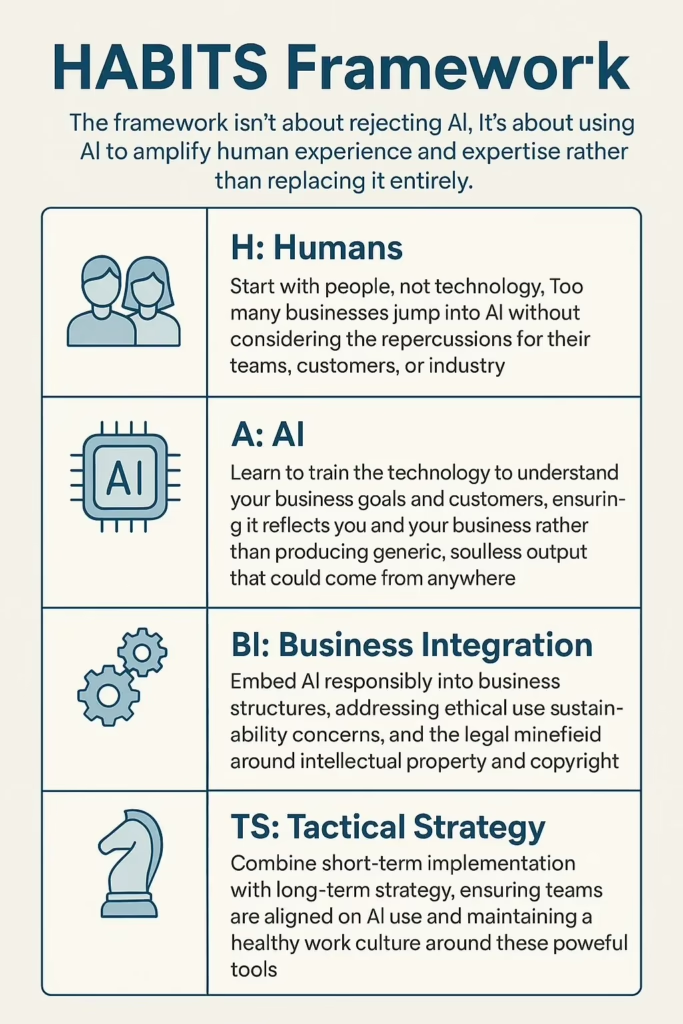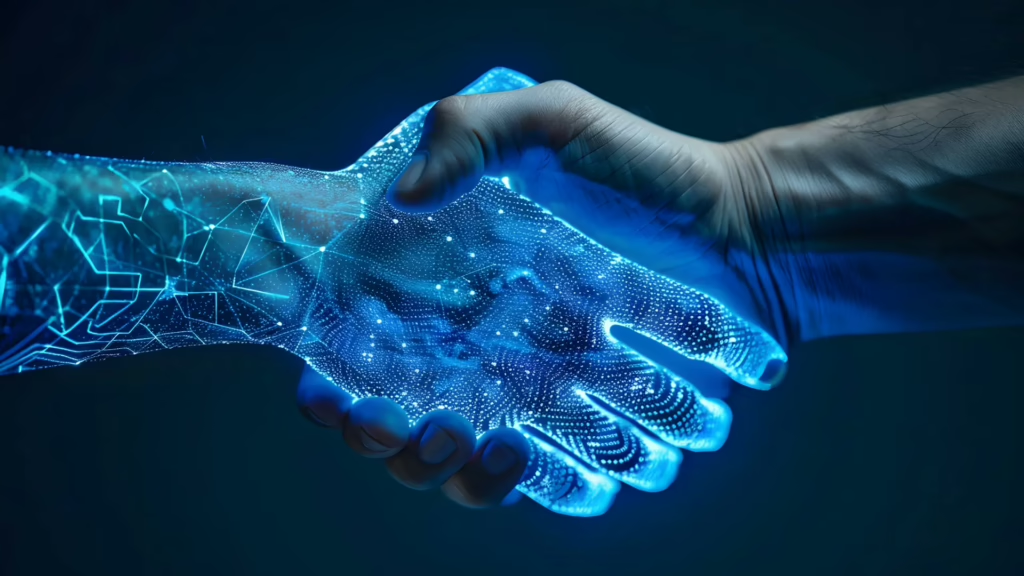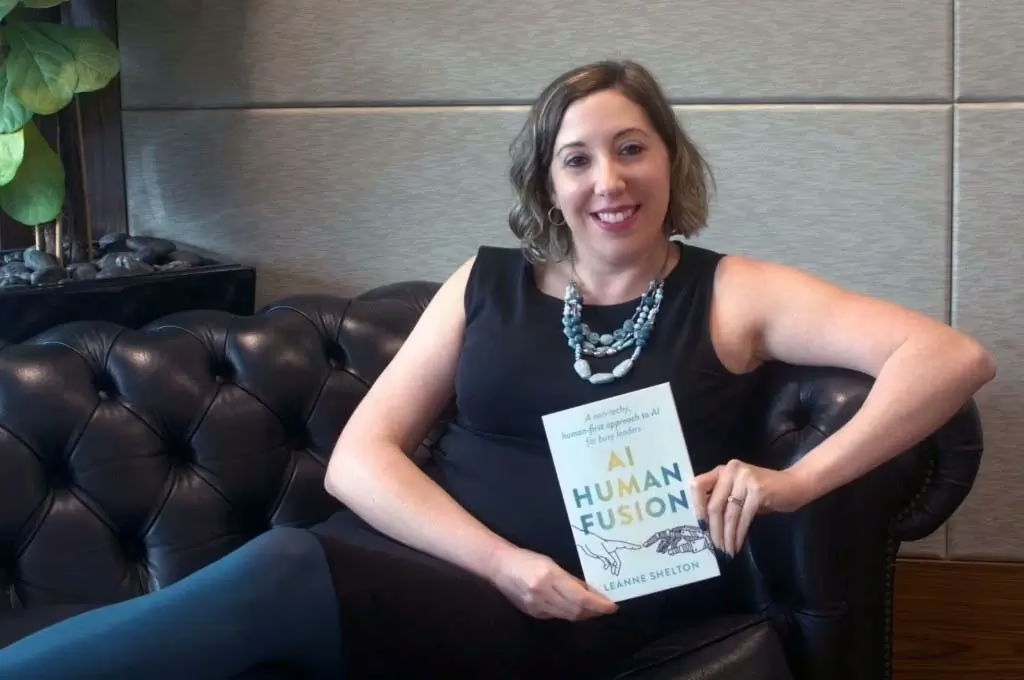Remember when AI was supposed to be the future? That gleaming promise of efficiency and automation that would somehow make life easier for, well, everyone?
Seems like we foolish, naïve humans may have jumped the gun a bit with that prediction. AI may be helpful in some instances. However, it’s also causing some real harm to specific industries.
For Leanne Shelton, owner of Write Time Marketing, the future arrived with a jarring thud in early 2023. After nine years of building a successful six-figure copywriting and content marketing business, she suddenly found herself staring at a harsh new reality: fewer leads, declining conversions, and the unsettling presence of free AI competition that threatened everything she’d built.
Her phone had gone quiet. Her inbox wasn’t pinging with new inquiries. The business she’d carefully cultivated was withering, and she knew exactly why.
ChatGPT had entered the chat.
Instead of retreating, Shelton made a bold decision that would completely transform her career trajectory. She decided to fight fire with fire – not by competing with AI, but by teaching others how to use it without losing their humanity in the process.
Today, she’s carved out a unique niche as a Global AI Coach, helping businesses navigate the complex intersection of artificial intelligence and human creativity through what she calls a “human-first approach.” Her book, “AI Human Fusion: A Non-Techy, Human-First Approach to AI,” has become required reading for leaders trying to figure out how to integrate AI without sacrificing what makes their businesses authentically human.
The moment everything changed
Like many entrepreneurs, Shelton’s transformation didn’t happen overnight. It began with that sinking feeling that’s become all too familiar for creative professionals in the age of AI – the realization that technology might be coming for your livelihood.
“I was already feeling like my services were undervalued, so I freaked out a bit,” Shelton admits. The timing couldn’t have been worse. After reaching that coveted six-figure mark, she was finally hitting her stride. Then ChatGPT arrived, and suddenly everyone had access to what appeared to be her services for free.
Rather than bury her head in the sand, Shelton made a pivotal decision during a quarterly planning event with her networking group. During a conversation about ChatGPT, she decided to approach the challenge head-on by creating a webinar titled, “How to use ChatGPT and Still Sound Human.”
That webinar changed everything.
With 150 attendees signing up, Shelton discovered something crucial. There was enormous demand for guidance on using AI ethically and effectively. More importantly, people were hungry for a human perspective on artificial intelligence – one that didn’t get caught up in either the hype or the fear.
“I realized before long that it was so much more than just prompt stuff,” she reflects. “Everyone was jumping on the AI bandwagon, and it was irritating me to see poorly AI-generated content online because it affects human relationships and connections.”

The HABITS framework: keeping humans in the driver’s seat
From her transition experience, Shelton developed something she calls the HABITS framework – a structured approach designed to help businesses maintain what she calls a “human-first approach” to AI integration.
H – Humans: Start with people, not technology. Too many businesses jump into AI without considering the repercussions for their teams, customers, or industry. Shelton emphasizes prioritizing human experience and expertise before implementing any AI solutions.
A – AI: Learn to train the technology to understand your business goals and customers, ensuring it reflects you and your business rather than producing generic, soulless output that could come from anywhere.
BI – Business Integration: Embed AI responsibly into business structures, addressing ethical use, sustainability concerns, and the legal minefield around intellectual property and copyright.
TS – Tactical Strategy: Combine short-term implementation with long-term strategy, ensuring teams are aligned on AI use and maintaining a healthy work culture around these powerful tools.
The framework isn’t about rejecting AI. It’s about using AI to amplify human experience and expertise rather than replacing it entirely.
The human-first philosophy that’s changing everything
What sets Shelton apart in the increasingly crowded field of AI guidance is her unwavering commitment to what she calls “human-first AI.” This isn’t about being a Luddite or rejecting technological progress. It’s about knowing how to make AI serve people, not the other way around.
“Whatever purpose you are looking to achieve with AI tools, there must be a human component,” she emphasizes. “People are smart, and they know if someone doesn’t know what they’re talking about and is just relying on AI to be the ‘expert.'”
This philosophy extends beyond individual use to team dynamics and customer relationships. Shelton encourages leaders to think about their team members. Are they panicking about AI? Are they secretly using it incorrectly? Are they worried about being replaced?
“AI should handle mundane tasks with human oversight,” she explains. “Productivity and efficiency sound great, but where’s the human component? People want to talk to people. You can’t replace humans in everything.”
The mindset shift has proven transformative for her clients. Instead of viewing AI as a threat to human creativity, they learn to see it as a tool that can free up mental space for higher-level thinking and genuine human connection.
Learning from the front lines
Shelton’s research and coaching work have given her a front-row seat to AI’s impact across industries. She witnessed the panic among copywriters as their skills faced potential devaluation, watched virtual assistant (VA) agencies worry about replacement, and observed photographers discovering new efficiencies in managing their workflows.
But she’s also seen something more encouraging. The persistent value of human connection.
“Most people want to speak to humans,” she notes. “They’re not interested in conversing with bots 100 percent of the time.” Her own experience bears this out. While she embraces certain AI tools for efficiency, she still chose a human graphic designer for her logo, business cards, and book cover.
The key insight? Understanding how your unique human skills appeal to other humans becomes a competitive advantage in a world increasingly saturated with AI-generated content.
“That human effort is a selling point in a world where everyone is overusing AI,” she points out.
Cutting through the AI hype cycle
One of the most frustrating aspects of Shelton’s early exploration of AI was the flood of “prompt engineers” selling courses that only helped produce what she calls “unusable, generic garbage.” The LinkedIn ecosystem was particularly frustrating, with its AI-first mentality that seemed to prioritize efficiency over authenticity.
“Don’t feel pressured to use AI just because it’s there,” she advises. “Too many people are getting caught up in that dopamine hit of ‘look at what it gave me in 5 seconds,’ and they hit publish without critiquing it.”
Her book deliberately avoids the shiny-object syndrome that plagues most AI content. Instead of chasing every new update or promising revolutionary breakthroughs, she focuses on helping businesses establish clear boundaries between where AI stops and human experience begins.
This approach has resonated with leaders who are tired of being told they need to “AI-ify” everything or risk being left behind.
The surprising ROI of staying human
Perhaps the most compelling aspect of Shelton’s story is the business results that followed her pivot. While her traditional copywriting business was struggling, her new approach to AI coaching has thrived.
“It turns out that my passion for prompting a human-first approach to AI excites me even more than copywriting – even though I’ve been a writer my whole life! It turns out that most people are desperately seeking help to understand how AI and humans should interact in society – and I’m here to fulfil that need. I’m here to offer hope and guidance, based on my strong human connection values and extensive experience in copywriting and marketing. I’ve realized that as a non-techy entrepreneurial woman, I have a unique perspective to offer the world.”
This mirrors broader trends in how people respond to AI saturation. As generic, AI-generated content floods the market, audiences are increasingly drawn to voices that feel authentically human.
The lesson for other businesses? In a world where anyone can generate content in seconds, the scarcity isn’t in content creation – it’s in genuine human perspective and expertise.
The mindset revolution
At its core, Shelton’s approach is about mindset as much as methodology. Her book begins with the importance of human connection, asking a fundamental question that cuts through the AI noise. “It’s bots talking to bots. Why do we want this?”
Cultivating the right mindset about AI is the most important aspect of what she teaches. “It helps break through the noise around AI and helps you think about how you want to use AI and how you don’t want it in your world.”
This mindset work proved personally transformative for Shelton as well. When she first encountered AI’s writing capabilities, she faced what she calls an ethical conundrum. “Can I still call myself a writer if I have a tool that can now do it for me?”
She discovered the answer wasn’t about the tool. It was about the human intelligence and expertise she brought to using it effectively.

Building the future of human-AI collaboration
Shelton’s success in pivoting from traditional copywriter to AI coach demonstrates that the rise of artificial intelligence doesn’t have to mean the end of human expertise. It can mean its evolution and, in many cases, its increased value.
Since that first webinar, she’s appeared in multiple publications, spoken at conferences and summits, and built a thriving coaching practice. Her next project focuses on youth and AI education, recognizing that today’s students “will be the most impacted by how we use AI now.”
She’s particularly concerned about the disconnect between educational institutions that ban AI use and the workplace reality these students will soon enter. “College students have been told not to use AI, but they’re going to be entering a working world where they’re using AI, and they won’t know what to do with it.”
The human future in an AI world
Shelton’s journey from threatened copywriter to AI coach offers hope for professionals facing similar disruption. Her message is neither technophobic nor uncritically optimistic. It’s pragmatic and deeply human.
“Don’t feed into the fear-mongering,” she advises. “Just be aware of it, understand it, and then find your place where AI fits into a human-first approach.”
Her framework doesn’t promise that AI won’t change industries or eliminate certain roles. Instead, it offers a roadmap for maintaining human value in an increasingly automated world.
“If you’re using AI because you can’t think anymore, that’s a real issue,” she warns. The future belongs not to those who can use AI most efficiently, but to those who can use it while remaining authentically, irreplaceably human.

